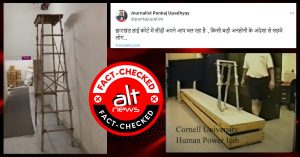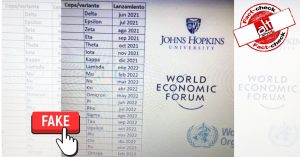The government of India, in collaboration with UNICEF, have initiated a vaccination drive for measles-rubella (MR) vaccine. This country wide program, started in February 7, 2017 to go until April 2019, has targeted to achieve 410 million children vaccinated (aged between 9 months-15 years), and has covered 17 states. The program is currently running in Gujarat, Haryana, Punjab and, Andaman & Nicobar Islands.
However, there have been several social media rumours circulated against this vaccine, particularly on WhatsApp, suggesting falsely, that it contains anti-fertility agents to sterilise their children, or worse, can cause their deaths.
These rumours are targeted at parents of young children and evoke fear in them causing them to shun this program. There are multiple versions of this rumour. One version is targeted particularly at the Muslim community, calling it “slow poison”, “a government conspiracy” or “an RSS plan”.
Rumour 1:
“*Very very Important msg*
Newly invented injection for Smallpox treatment *MR – VAC*. *But actually it is not true.* This medicine has been band in many countries. Now this MNC are sending this injection through this Modi government to all schools to inject all children compulsory. Please educate your children, not to take this injections at any cost. It is slow poison which will affect the future of the child as well as future generations also.”
Rumour 2:
“Dear brothers and sisters assalamualikum all the schools have decided to give an injection for your childrens all over india so dear brothers dont let your children’s get that injection object that in your child’s school it’s an RSS plan in which your children when they will turn around 40 they wont be able to have thier kid one teacher in kerla have told taht this injection should put to Muslim children’s only so kindly do not let them get this injection for your children’s safety.”
These rumours were re-fueled recently when 4 deaths were reported in Gujarat, 30 to 115 hours after vaccination, in addition to 14 similar incidences of children’s death in 21 states where the MR vaccination drive was carried.
These rumours are still in circulation despite the central investigating team ruling out any linkage between these deaths and MR vaccines. The team leader of the health officials from the Ministry of Health & Family Welfare (MoH&FW), Dr. Haldar, commented that these deaths were due to other medical conditions and not due to the MR vaccine.
In this article, we will discuss:
- The measles-rubella (MR) disease & its vaccine constituents,
- How effective are the MR vaccines in preventing diseases?
- People who can and cannot get the MR vaccine
- The rumours & side effects of MR vaccine, &
- The benefits of MR vaccine as well as the ill-effects of avoiding vaccination
1. The measles-rubella (MR) disease & its vaccine constituents
It is a severe disease, often complicated by middle-ear infection or bronchopneumonia and can be a major cause of illness and death.
Encephalitis (brain inflammation) occurs in approximately one of every 2000 reported cases that can lead to permanent brain damage and mental retardation. Death, from respiratory and neurological problems, occurs in 1 per 3000 reported measles cases. The risk of death is greater for infants and adults, than for children and adolescents.
Rubella virus is transmitted by the respiratory route and replicates in the nose, throat and the local lymph nodes. In the blood, its presence occurs 5-7 days after exposure and then spreads to different organs. Symptoms can be transient rash, joint pain and arthritis.
Infection in early pregnancy leads to congenital rubella syndrome which may result in multiple fetal defects in up to 90% of cases, affecting many organs which often results in miscarriage or stillbirth. Infants who survive after congenital rubella syndrome can face major developmental disabilities.
A number of live, attenuated vaccines for measles and rubella are available such as combination measles-rubella vaccine (MR) or, in combination with mumps vaccine (MMR). The vaccine is generally injected subcutaneously, although intramuscular administration has also been shown to be extremely effective. The virus in the vaccine is live but with reduced virulence and is harmless in healthy humans. These MR vaccines in India are courtesy of Serum Institute of India.
In addition to the weakened viruses, these vaccines may contain ingredients required during the manufacturing and production. These include emulsifiers, stabilizers, preservatives and adjuvants and have also been deemed as completely safe by WHO and other regulatory bodies.
2. How effective are the MR vaccines in preventing dieases?
From studies conducted in highly vaccinated American schools, one dose of measles vaccine administered at 12 months or more was approximately 94% effective in preventing measles, and was ≥99% in two studies with 2 doses of measles vaccine.
Measles outbreaks among populations that have received 2 doses of measles-containing vaccine are uncommon.
Age can impact the effectiveness: In an epidemiological study, the 85% vaccine effectiveness represented children vaccinated at age 12 months, whereas the ≥94% vaccine effectiveness represented children vaccinated at age ≥15 months
Two doses are better than one: Studies found the incremental effectiveness of 2 doses was 89% and 94%, compared with 1 dose of measles vaccine.
Outbreaks of rubella in populations vaccinated with the rubella RA 27/3 vaccine strains are rare. Available studies demonstrate that vaccines containing the rubella RA 27/3 strain are approximately 97% effective in preventing clinical disease after a single dose.
3. People who can and cannot get the MR vaccine
Although MR vaccine is safe and available for every child between 9 months- 15 years in the 2018 vaccination program in India, the optimal age for MR vaccination is between 12-15 months.
However, people should not be vaccinated if they have any of the following:
- Known allergies to MR vaccine, or antibiotic neomycin, or any other component of MMR vaccine: Allergies can be of any form and the cause can be anything from grass, pollen or peanuts. Vaccination should not be given in the event of a known allergy from a previous experience of MR vaccination or neomycin. if in doubt, a patch test or an intradermal test can confirm the existence of an allergy. The allergic symptoms, such as dermatitis or anaphylaxis can be treated immediately, by oral or topical corticosteroids, or by an epinephrine autoinjector, e.g. Epipen
- Pregnant women: Women should avoid pregnancy for at least a month after getting the MR vaccine and get it after they are no longer pregnant.
- Cancer or other diseases that weakens immune system
- AIDS or HIV infection that renders patients immuno-compromised
- Medical treatments such as radiation, immunotherapy, steroids, or chemotherapy also reduces immunity
- Immediate relative who has a history of immune system problems such as a parent, a brother, or a sister
- A history of condition that makes them bruise or bleed easily
- A recent history of blood transfusion or recipient of other blood products. Advisable to postpone MR vaccination for a period of more than 3 months
- Tuberculosis infection
- A recent history of other live vaccines in the past 4 weeks
4. The rumours & side effects of MR vaccine
The MR vaccine is safe and effective at preventing measles, and rubella. Although, vaccines, like any medicine, can have side effects but getting the vaccine is much safer than getting measles, or rubella.
Most people who get MR vaccine do not have any serious and long-term problems with it. Contrary to the claim in the rumour above, there is no known link between MR vaccine and mass-sterilization.
Contrary to several other rumours linking autism and MR vaccine, there is no evidence of this link between vaccine and autism. Several studies have reported and published as primary data as well as in the form of systematic reviews of other published data. Also, the original research article by Wakefield claiming this cause-effect relationship was retracted for being fraudulent which was reported by the British Medical Journal (BMJ) in 2011.
Some side effects of the vaccine can be sore arm from the shot, fever, mild rash, temporary pain and stiffness in the joints.
A review of scientific literature, case studies and statistics on adverse reactions to vaccines reported that immune thrombocytopenic purpura (decreased blood platelets) and febrile seizures with fever, can be a rare side effect emerging from MMR (measles, mumps & rubella) vaccine.
This decrease in blood platelets is rare and not life-threatening. It is temporary and usually goes away without treatment. The approximate rate of occurrence is 1 per 20,000 doses.
The febrile seizures are also rare and are not associated with any long-term effects. The approximate rate of occurrence is even smaller at < 1 per 1,000,000 doses. Also, the risk of febrile seizures increases as child get older and hence, it is recommended that they get vaccinated as early as possible.
In extremely rare cases, a child may have a serious allergic reaction to MR vaccine. Hence, it is recommended that those who have had known life-threatening allergic reactions to the antibiotic neomycin, or any other components of MR vaccine, should not be vaccinated.
The overall risk of any side effects were calculated in a systematic review of 186 eligible studies on MMR vaccinations published in ‘Medicine’ journal in 2015. It reported that, in incidences of any adverse events, only about one-tenth of the events were considered to be related to vaccination studied. And about half of the related events were febrile seizures (that have no long-term effects). The incidence of related febrile seizure was under 0.8‰ in MMRV (mumps, measles, rubella, varicella) groups.
5. The benefits of MR vaccine
Vaccination will protect your child as well as others from measles & rubella
When you are vaccinating your child, you are not just protecting your child but also others in the community. Infections travel a lot faster in the community (person-person) which can lead to an epidemic. By vaccinating, you are avoiding this rapid spread by which an entire community can prevent the infection. Subsequently, you are protecting people, especially young children, from getting infected who cannot or have not vaccinated yet.
For example, in large joint families or day-care centres, where children of all ages come in contact with each other, babies younger than 12-15 months old who have not been vaccinated yet, can get infected even if one child or adult has not been vaccinated. In such babies, such infections are often very serious and life threatening.
Hence, babies are the most vulnerable and 100% community vaccination protects them via the immunity of playmates, parents or extended joint families, and this immunity is called ‘herd immunity’. Contrarily, even if older children are vaccinated, younger babies will always possess a risk due to non-vaccinated individuals coming in contact with the baby.
Conclusion
Contrary to the claim in the rumour above, there is no known link between MR vaccine and mass-sterilization in a particular religious community as the same vaccine is given to other religious communities.
Common mistakes such as believing in rumours about sterilisation, autism and deaths associated with MR vaccination include assuming a causal relationship based on a temporal association of affected patients.
Factors fueling these rumours include lack of trust in the government and health care workers, timing during which autism is detected -which is around the same time as a large number of children get vaccinated, as well as vulnerability of babies who can be prone to infections or deaths in that age group. Such infections or deaths are a correlation but not a causation as the central investigation report had identified.
Both, the benefits of vaccination and the ill effects from not taking it, are many.
A similar anti-vaccination campaign, in a form of a rumour for polio vaccine, was prevalent in Nigeria in the 2003-2004, which sustained for 15 months, where, due to the lack of trust in the military, Nigerian parents did not get their children vaccinated. The rumour also suggested that the polio vaccine had anti-fertility agents that resulted in the subsequent boycott of the vaccine.
We are still seeing the long-term ill effects in Nigeria as it is the only African country where polio has mass-prevalence. Currently, Nigeria accounts for 86% of the polio cases in the African continent.
Health rumours have the potential to fuel an epidemic, also called a ‘misinfodemic’ and affect several people very rapidly, the only way to protect is to immunize through vaccinations and discerning false information from the truth.
For further information on measles and rubella vaccines morbidity and mortality, refer to the scientific report by the American Centre for Disease Control and Prevention (CDC).
For further guidelines and recommendations of vaccines, refer to the WHO pages on different vaccines.
Independent journalism that speaks truth to power and is free of corporate and political control is possible only when people start contributing towards the same. Please consider donating towards this endeavour to fight fake news and misinformation.




